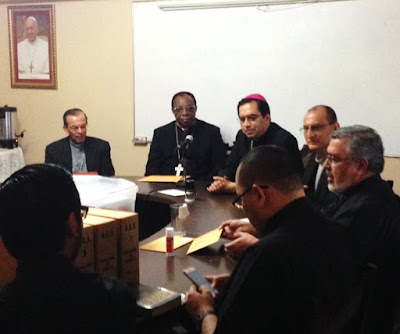JUBILEE YEAR for the CENTENNIAL of BLESSED
ROMERO, 2016 — 2017
|
||
|
|
||
 |
| The Tribunal, L-R: Aux. Bp. Rosa, Nuncio Kalenga, Abp. Escobar, Bp. Iraheta, Msgr. Urrutia and Fr. Henriquez. |
The Salvadoran
Church has concluded the local investigation of an alleged miracle by the intercession
of Blessed Oscar Romero, assassinated at the altar at the start of the
Salvadoran Civil War. The findings of an
ecclesial tribunal were sealed in San Salvador on Tuesday, February 28, 2017
and remitted to the Apostolic Nunciature—the Vatican’s Embassy in San
Salvador—to be sent to Rome. If the
miracle is confirmed by the Congregation for the Causes of Saints in Rome, it
would put Romero on track to becoming the first Salvadoran saint. [Read the latest.]
Although no
formal announcement was made, the event was confirmed by a series of tweets
from Msgr. Rafael Urrutia, the vice postulator of the cause, and Fr. Edwin
Henriquez, the second vice postulator. Msgr.
Urrutia confirmed by tweet, “This morning
we have closed the Diocesan Process for a miracle attributed to Blessed Oscar
Romero and it will be sent to Rome.”
Photos posted in social media showed Fr. Henriquez delivering the boxed
up documentation to the Nunciature.
Update: Archbishop Vincenzo Paglia, postulator of the cause, revealed the details of the case in an interview with the Italian church radio. “It is the healing of a pregnant woman that at first glance seems inexplicable. We hope the miracle will be recognized,” he said. The believer has been identified in various media but Super Martyrio will refrain from revealing her identity until she decides to come forward. Archbishop Paglia described her as “a woman in her seventh month of pregnancy, which was proceeding very badly. According to the clinical data she was expected to die together with the baby. Inexplicably, however, the lady recovered. On the basis of how she overcame that tragic moment, some doctors whom I have consulted have considered her cure inexplicable. At the same time some people had prayed to Mons. Romero for her recovery.”
Update: Archbishop Vincenzo Paglia, postulator of the cause, revealed the details of the case in an interview with the Italian church radio. “It is the healing of a pregnant woman that at first glance seems inexplicable. We hope the miracle will be recognized,” he said. The believer has been identified in various media but Super Martyrio will refrain from revealing her identity until she decides to come forward. Archbishop Paglia described her as “a woman in her seventh month of pregnancy, which was proceeding very badly. According to the clinical data she was expected to die together with the baby. Inexplicably, however, the lady recovered. On the basis of how she overcame that tragic moment, some doctors whom I have consulted have considered her cure inexplicable. At the same time some people had prayed to Mons. Romero for her recovery.”
According to
Julian Filochowski, the head of the Romero Trust in London, the documentation
contains specific findings from medical records relating to the case. “This
will then be studied in Rome, in turn, by a 7-person commission of medical
experts, a 6-person commission of theologians, and the fourteen Cardinals of
the Congregation. If all concur, a new ‘Positio’ dealing with the miracle will
be submitted to Pope Francis for final approval of the canonization.”
The medical
commission to be impaneled in Rome will be chosen from a body called the Consulta Medica, which is made up of
about 100 renowned Italian physicians. New rules promulgated by Pope Francis
last year, tightening up the procedures relating to the Roman phase of the
investigation, require that at least 5 medical experts out of the 7-member panel
(or 4 out of 6 if a 6-member panel is used), approve the certification. If the
reported miracle is rejected, it cannot be examined again by the same
consulting group; and in no case can one report be examined more than three
times.
The progress
comes as the Salvadoran bishops prepare to meet with Pope Francis during their
“Ad Limina” visit which will take
place on March 24—the anniversary of Romero’s assassination. The date has raised hopes that the Pope will
be in a position to approve Romero’s canonization, though those knowledgeable
with the process doubt that the necessary lower level approvals by the medical
experts, theologians, and cardinals could be obtained in time.
It remains to be seen whether Romero’s Roman phase will advance with unusual celerity, which would be required to canonize Romero this year, the centennial of his birth, or whether his cause will advance at the usual pace, for which eighteen months would be seen as smooth sailing.
Update: In a Tweet of his own on March 2, Archbishop Vincenzo Paglia, Postulator of the cause, expressed hope that Vatican approval could come by the 24th, asking Romero devotees to pray for it.
It remains to be seen whether Romero’s Roman phase will advance with unusual celerity, which would be required to canonize Romero this year, the centennial of his birth, or whether his cause will advance at the usual pace, for which eighteen months would be seen as smooth sailing.
No doubt
cognizant of the stakes, Msgr. Urrutia tweeted, “We ask Christian devotees of Archbishop Romero to pray for his canonization.”











